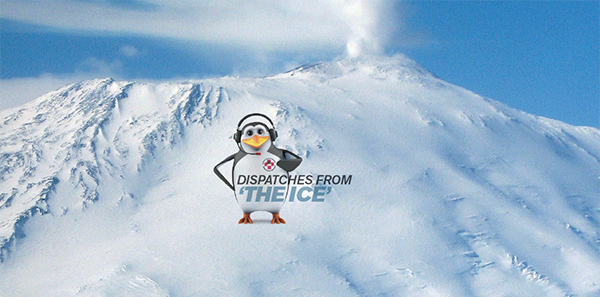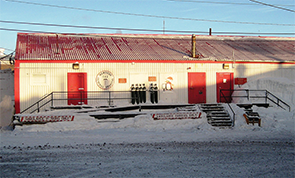
“How do you get to Antarctica?” may be the third most common question I get when I tell people I’ll be spending the winter there. (The first, of course, is, “How cold is it?” The answer? “Colder than a … !” You get the idea.)
Explore This Issue
ACEP Now: Vol 35 – No 03 – March 2016After several days’ delay in Christchurch, New Zealand, due to very bad weather on The Ice, I arrived at Antarctica’s McMurdo Station. The 2,180-mile trip took about five hours in a US Air Force C-17 plane. If we had taken the alternative, a C-130, the trip would have been an excruciating eight hours. Neither plane has the amenities you expect when flying. They do provide a bag lunch, but heating is minimal, there are few windows, most seats are webbing, and the “bathroom” is a bucket surrounded by drapes.
Antarctica, the continent I’ll be living on for the next seven months, has a surface area of 5.4 million square miles, 1.4 times the size of the United States. This makes it the fifth largest continent. Almost 98 percent of the continent is covered by an ice sheet that averages 6,000 feet (more than one mile) thick. Antarctica has 70 percent of the world’s fresh water, frozen as ice. Yet, to our knowledge, explorers only reported seeing it in 1820 and landed on the continent in 1821. Explorers first “overwintered” there in 1898, a tradition I will be continuing.
McMurdo Station sits at the southern tip of the volcanic Ross Island, at the edge of the Ross Ice Shelf and the Ross Sea. The 13,300-foot Mt. Erebus, an active volcano, towers above the station. Our plane lands on a constantly maintained airfield on the Ross Ice Shelf. It’s disconcerting to realize that this enormous cargo aircraft is setting down on ice covering the very deep Southern Ocean. I’m comforted in knowing that experts maintain this airfield—a huge undertaking given the extreme cold and frequent gale-force winds—throughout even the mildest (everything is relative) times of the year.
Antarctic Welcome

The hospital clinic at McMurdo Station.
When do you really know you’ve arrived? As the plane descends toward the airfield, everyone receives the instruction to “bundle up,” meaning that they should don all of their extreme cold weather (ECW) gear. This sounds extreme until they open the passenger door and we’re suddenly hit by the brutal cold.
Of course, you’re greeted by the indigenous population with native dances and flower leis. Just kidding! (The second most common Antarctica question I get is about the indigenous population.) The largest indigenous life forms in Antarctica are nematodes (roundworms) that are found in a few areas of the continent. Mostly, there are microorganisms but no insects. The only people on the continent are scientists and their support teams. The number varies, from around 4,400 in the “summer” months of October through February to around 1,100 during the Antarctic winter. Although many countries have Antarctic research stations, the only ones with at least 100 people during the peak months include Argentina, Australia, Chile, France, Italy, Japan, Russia, the United Kingdom, and the United States.
I bundled up and emerged from the plane to climb onto Ivan the Terra Bus, which takes us to general orientation in the dining hall. The dining hall, which also serves as the community center for group activities, is spacious enough to accommodate the large summer population. As the winter crew, we make a small dent in the space, spreading out to be comfortable and to sit with the people we know. Outgoing staff drone through the orientation that they’ve been giving at least twice a week throughout the summer. It sounds like every other orientation you’ve ever heard, with most people too tired even to take in the important information.
Then comes the vital stuff: getting room assignments and keys and doing the “bag drag” to get your luggage to your room. I met briefly with the outgoing summer medical-dental crew but started official on-Ice medical equipment and procedure orientation the following day. I went back to the building that houses my room and tried to unpack a few things. I was tired enough that I considered just lying down on the unmade bed and going to sleep, but I had enough stamina to make the bed and even go for a quick meal before I crashed for the night.
To get from the building where I live to the medical building, I subscribe to the common McMurdo truism, “The shortest path from one place to another on the station is through a heated building.”
Waking up is a bit tough since McMurdo time is four hours earlier (and one day later) than in my hometown of Tucson, Arizona. However, after my morning ablution, I climbed back into my ECW gear to make my way over to the dining hall for breakfast. The buildings we live and work in are warm enough, so wearing normal clothing plus some long underwear suffices to keep us toasty. To get from the building where I live to the medical building, I subscribe to the common McMurdo truism, “The shortest path from one place to another on the station is through a heated building.” This first morning’s breakfast is good, hot, and plentiful. We’ll see how it goes as the season progresses and fresh food disappears from the menu.
Getting to Work
From there, I headed over to the hospital/clinic to meet up with both my nurse practitioner partner and the South Pole crew to orient on the X-ray machine (we take our own films), the very modern ultrasound, the new defibrillator/monitors, the dental materials and equipment (I’m also the “dentist”), the pharmacy, and the maintenance equipment such as the medical sterilizer. We also learned the current procedures for obtaining telemedical consultations, completing the ever-present forms, and making periodic connections with our home base at University of Texas Medical Branch in Galveston.
Happily, the wind had not yet picked up enough to cover one entire side of our building or fill the clinic’s entryway with snow. We crunched easily across the ice as we walked through town, grateful for the thin gray light that was still available for a few hours each day. That won’t last long for, as they say in Game of Thrones, “winter is coming.”
Dr. Iserson is professor emeritus of emergency medicine at The University of Arizona in Tucson.
Pages: 1 2 3 | Multi-Page





No Responses to “Cold Temperatures Greet Emergency Physician Spending Winter in Antarctica”